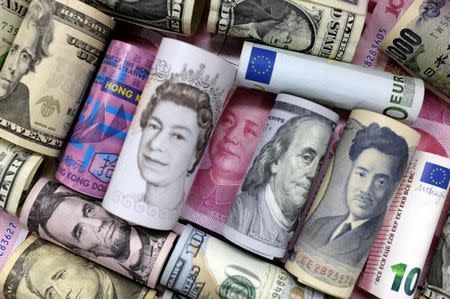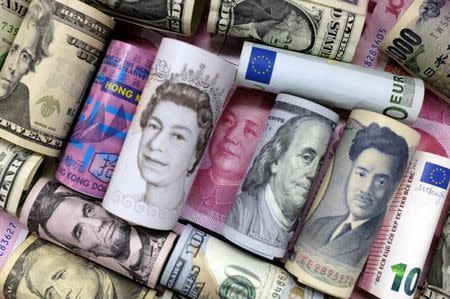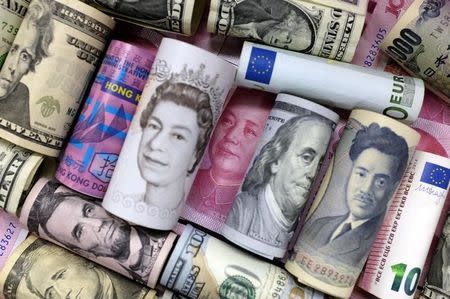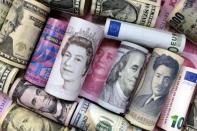China central bank resumes easing cycle to cushion reform pain
By Pete Sweeney
BEIJING/SHANGHAI (Reuters) - China's central bank resumed its easing cycle on Monday, injecting an estimated $100 billion worth of long-term cash into the economy to cushion the pain from job layoffs and bankruptcies in industries plagued by overcapacity.
The People's Bank of China (PBOC) said on its website it was cutting the reserve requirement ratio, or the amount of cash that banks must hold as reserves, by 50 basis points, taking the ratio to 17 percent for the biggest lenders.
The cut came just days after China used its role as host of the Group of 20 (G20) to reassure trading partners that it did not intend to further devalue the yuan, after a surprise 2 percent devaluation last August threw markets into a spin.
The PBOC's announcement also comes shortly before the annual meeting of China's parliament, which must try to engineer a huge economic shift towards services and consumption and away from basic manufacturing, while also keeping growth stable.
The move was a surprise to some observers, given that the PBOC had previously said it would rely more on daily injections of short-term money to keep cash flowing, rather than the long-term addition of funds from an RRR cut.
The cut is effective from March 1, and it comes after signs of increasing tightness in the money market last week, despite repeated daily injections through open market operations, including a 230 billion yuan injection on Monday morning.
"This reflects the central bank is keen to ease liquidity in the China banking sector," wrote Iris Pang, a senior economist at Natixis in Hong Kong.
Pang estimated the move would release 689 billion yuan ($105 billion) into the system for fresh lending; economists at ANZ bank estimated the injection at about 650 billion yuan.
Some of that lending could help struggling industries meet the costs of restructuring.
Economists said the cut suggested regulators were less worried that the move would hammer the exchange rate , and by extension accelerate the rate of capital outflows.
Official data showed China's central bank and commercial banks sold a net 629 billion yuan ($95.61 billion) worth of foreign exchange in December, an implicit outflow from yuan assets.
"Previously the PBOC had stated it was worried that further RRR cuts would undermine the yuan," said Mark Williams at Capital Economics in London.
"So this shows that either the pressure is not so strong anymore or that the they've changed their mind following the tighter monitoring of exchange flows we've seen recently."
Offshore yuan and onshore yuan both fell against the dollar following the news, but losses were limited.
China last cut the RRR on Oct. 23, when it also reduced interest rates by 25 basis points to rein in financing costs for China's heavily indebted firms.
Monday's move suggests it remains worried structural reforms could destabilise growth and increase unemployment if not cushioned by accommodative policy.
BRIEF HIATUS
The PBOC said the RRR cut would help create an appropriate monetary environment to support a "supply-side reform" project Beijing hopes will put the world's second-largest economy on a more sustainable growth path.
The problem has been that weak demand at home and abroad, combined with high debt service costs, has punished margins at many Chinese firms, with recent data showing rising negative pressure on wages and job creation.
On Monday, Chinese regulators said they expect 1.8 million workers in the steel and coal sectors will be laid off as a result of structural reforms, but said this should not result in a spike in unemployment.
Beijing had previously announced a 100 billion yuan fund to help retrain laid off workers.
"China's government is pushing forward the 'supply-side' reform and the move needs someone to pay the costs. A loosening monetary environment is what we need," said Li Huiyong, an economist at Shenyin & Wanguo Securities in Shanghai.
"We believe the central government will keep its loosening policy stance this year to support the economy."
That tightness in the money market has been blamed for denting sentiment among stock investors, who have embarked on another round of sharp selloffs since last Thursday. [.SS]
Chinese banks, armed with fresh lending quotas, extended a record 2.51 trillion yuan of new loans in January, suggesting Beijing was keeping monetary conditions loose to counter a protracted economic slowdown.
The world second-largest economy grew 6.9 percent in 2015, its slowest pace in 25 years. A spate of soft data points to further weakness at the start of the year as Beijing struggles to cushion the slowdown.
Chinese leaders outlined initiatives after a policy meeting last October, where they reiterated goal of doubling GDP and incomes between 2010 and 2020 and committed to liberalising the service sector to foreign investment.
(Reporting by Kevin Yao, Shao Xiaoyi, Nicholas Heath, Nathaniel Taplin; Writing by Pete Sweeney; Editing by Mike Collett-White)











